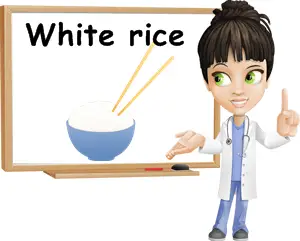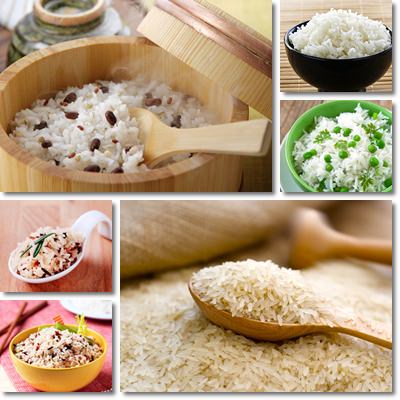Interesting enough, rice dominates both wheat and corn consumption. Although this cereal grain may not be as nutritious as oats, red rice or brown rice, its culinary versatility has gained much appreciation worldwide. A cup of boiled white rice, mixed with a little olive oil, mushrooms or meat stands for a pretty nutritious meal, despite the fact that the variety doesn’t have the most prominent nutritional profile on its own.
Still, white rice is a good source of vitamins B5 and B6 and contains good amounts of manganese, phosphorus and zinc. Pair it with a favorite vegetable and a sprinkle of olive oil and you have yourself a healthy, nutritious meal. Let’s not forget that rice, no matter its color, has no gluten and is thus perfect if you are suffering from either Celiac disease, gluten intolerance or gluten sensitivity. Moreover, white rice is the perfect food for treating diarrhea of non-infectious causes as it’s absorbent. It also has no real taste in the sense that it lacks flavor altogether. Foods like this, with a flat, bland taste, are good to eat if you have nausea or can’t keep food down because of a stomach bug (paired with a fresh apple, for example).

Where does white rice come from?
White rice actually comes from brown rice. After harvesting, brown rice seeds undergo special processing in order to remove an outer layer called husk, the layer underneath it called the bran and the germ (from which the future seed will emerge). What is left, more exactly the least nutritious part of the rice seed is commercialized as white rice. In a way this is good because rice crops are treated with great amounts of pesticides and herbicides which the outer layers of the seeds, namely the husks, may retain in heavier amounts.
Nevertheless, when processing the seeds to obtain white rice, important amounts of nutrients are lost. Some producers enrich their white rice with vitamins, but a simple rinse may clear the rice of all added nutrients. Some ‘products’ used to enrich rice may even pose threats to one’s health. Overall, brown rice is considerably more nutritious than white rice, as are red rice and purple rice varieties.
Rice bran oil
Rice bran oil, the oil obtained from the discarded rice husks, is a good source of unsaturated fatty acids, especially Omega-6 (linoleic acid) and Omega-9 (oleic acid). Rice bran oil contains some incredibly heart-friendly antioxidants which help reduce LDL (bad) cholesterol and triglyceride levels and increase HDL (good) cholesterol levels for better overall cholesterol numbers and cardiovascular health.

What are the benefits of White Rice?
Eating refined white rice does have its benefits. For example, white rice is a good source of vitamins B5 and B6 and minerals such as manganese, phosphorus and zinc. Vitamin B5 supports brain function and prevents muscle weakness and digestive disorders due to it contributing to carbohydrate metabolism and digestive health.
Vitamin B6, or pyridoxine, has anti-inflammatory action and helps maintain healthy lymphoid organs (the organs that produce white blood cells). About 100 g of uncooked white rice provides more than 50% of the RDA of manganese, an antioxidant-mineral which protects cells against free radicals and oxidative stress. Phosphorus is important for bone health, while zinc supports immunity.
White rice is also a good source of carbohydrates which give us energy to go up and about all day long. Being low in sugar, fat and sodium, it is especially good for anyone suffering from high blood pressure. Excess sodium can cause veins and arteries to constrict (shrink), increasing strain on the cardiovascular system. A fatty diet means fat will deposit on artery walls, restricting blood flow and causing atherosclerosis. For this reason, it is best to consider leading a low-cholesterol and low-fat diet, especially if you are at risk of cardiovascular disease.
Another very important health benefit of white rice concerns its effect on stomach health. If you are experiencing loose stools or diarrhea, either eat a bowl of plain, boiled white rice or drink a cup of the water in which you boiled some white rice. This will almost instantly help bind your stools and treat your diarrhea, without any side effects. You may have to continue this dietary regimen for 2-3 days maximum, depending on how bad your diarrhea is.
Fortunately, you can add vegetables such as boiled carrots or string beans or mushroom to the rice for a better taste and to improve its nutritional value. However, if your diarrhea is of infectious cause, it might be best to also have your doctor prescribe you an antidiarrheal such as furazolidone which disinfects the digestive tract. Even so, white rice is one of the best foods to eat for diarrhea. Find out more about what to eat for diarrhea.
As mentioned above, rice is also good for gastroenteritis, also known as infectious diarrhea, stomach virus, stomach flu or stomach bug. While it will not treat the infection (digestive tract antimicrobials such as furazolidone are needed), it will allow you to stay well-fed and relieve the diarrhea by binding the loose stools. Because nausea and lack of appetite may also occur, what I like to do is grate an apple over the plain, boiled white rice. I guarantee this will help you eat it despite the nausea. Also remember to drink a lot of fluids to keep hydrated if you have diarrhea.
White rice is also absorbent and thus a good food to eat for gastritis, helping absorb excess stomach acid and calm gastritis flareups. Find out more about what foods to eat and to avoid for gastritis and see my 1 week gastritis diet plan that includes white rice as a staple food.
Last but not least, white rice is gluten-free, making it ideal for Celiac disease sufferers or for those of you who are gluten sensitive or allergic to wheat. The trouble with gluten is that not everyone can digest it. In some people’s case, gluten is attacked by antibodies, which see it as a threat for their body. This abnormal immune response causes the small intestine to get inflamed, disrupting normal digestion and nutrient absorption. In order to prevent further damage to the small intestine, a no-gluten diet is imperative. White rice, oat, brown rice, amaranth, buckwheat and quinoa are all gluten-free cereals with a good nutritional profile.
Potential side effects of White Rice
Remember to always check your rice package for nutritional and other information and choose products from reputable producers, grown in uncontaminated areas. Rice in general absorbs more water from the ground than other cereals and, with it, arsenic and possibly other heavy metals which then accumulate in the grains. Whether it is naturally present in the ground in higher than normal amounts or as a result of excessive use of pesticides or other agricultural practices, arsenic levels in rice are a potential health concern. Depending on the region where it is cultivated, agricultural practices, previous crops grown on the same land, soil quality, water quality, presence of contaminants in soil, water and surrounding environment, whether there are industrial activities being carried out in proximity and other factors, arsenic content in rice may vary greatly.
Because the naturally occurring arsenic in rice is hazardous to human health, it’s important to carefully regulate the amount of rice in the diet of small children. Children are much more susceptible to contaminants in food and may develop more serious health issues as a result of excessive intakes. Of course, this does not mean we should stop eating rice, just keep to a moderate, reasonable intake.
